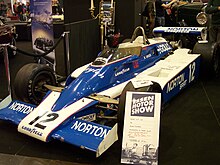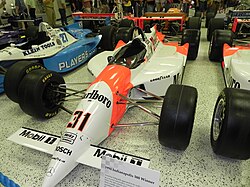Championship Auto Racing Teams
The Championship Auto Racing Teams (CART) was an automobile championship based in the United States, contested with single-seaters between the years 1979 and 2003. In 2004, it was acquired by the Open-Wheel Racing Series Inc. (OWRS) after financial problems and transformed into the Champ Car, which disappeared in 2008.
Founded in 1979 by United States Auto Club (USAC) team owners after conflicts with the organization and succeeded the USAC National Championship. That first season was called the SCCA/CART Indy Car Series. It was later called the CART PPG Indy Car World Series and CART FedEx Championship Series. Its last season, before being acquired by the OWRS, even carried the name Champ Car.
In 1996, new conflicts led to the creation of the Indy Racing League (now the IndyCar Series), which became a rival series to CART until the latter's demise.
History
In 1909, the American Automobile Association (AAA) became the first motoring entity in the United States by creating the national championship. After the 1955 Le Mans disaster, AAA withdrew from motorsports, and in 1956 Tony Hulman founded the United States Automobile Club (USAC). to take over the organization of the USAC National Championship.
Formation of the CART
The split from USAC in 1978 was prompted by a group of car ownership activists who viewed USAC as a sanctions agency. Likewise, the group of fans complained about the bad promotion, and they allied themselves with Dan Gurney, who in 1978 wrote what became known as the Gurney White Paper, in which he proposed a plan for the creation of from an organization called Championship Auto Racing Teams (CART). Gurney was inspired by the improvements that Bernie Ecclestone had implemented in Formula 1 with the creation of the Formula 1 Constructors' Association. The white paper called on team owners to form CART, or a national advocacy group. to promote the USAC National Championship and do the work that this entity did not do. The group would also work to negotiate television rights, and maintain some seats on the USAC governing body. Gurney joined other team leaders including Roger Penske and Pat Patrick in submitting their demands to USAC, but they were rejected.
USAC's rejection of the proposal led the three owners to form a new series (CART), under the principles established in the Gurney White Paper. The new series quickly garnered support from most teams and their owners, with the exception of A.J. Foyt, CART's inaugural season was held in 1979.
The novelty of the organization prevented it from being recognized by the representatives of the International Automobile Federation in the United States. An agreement was reached with the Sports Car Club of America (SCCA), where the SCCA would act as the sanctioning body for the new series, which would allow the events to be listed on the international automobile calendar.
With the exception of Foyt's team, the most established teams started the season, which consisted of 20 races, of which 13 were part of the 1979 CART championship, of the 10 tracks to host races, 5 would receive exclusively racing competitions. the CART, and only Ontario Motor Speedway would host competitions from both series.
Predominance of foreign pilots
CART, like its predecessor USAC, was dominated by American drivers including Mario Andretti, Bobby Rahal and Danny Sullivan. Some found success in the series, followed by former Formula 1 champion Emerson Fittipaldi, prompting other drivers from South America and Europe to join the series.
British driver Nigel Mansell, the 1992 F1 champion, came to the series in 1993 and beat Brazilian Emerson Fittipaldi for the championship. Mansell's victory, coupled with the disastrous F1 performance of 1991 CART series champion Michael Andretti, was seen as a sign of the superiority of non-American drivers. This, combined with CART's move to include more road courses in place of ovals, led to a breakup of the series after the 1995 season due to a dispute between CART owners and Indianapolis Motor Speedway owner Tony George..
Break with the Indy Racing League
After his resignation from the CART board of directors, George went on to form a new category, the Indy Racing League, which initially included a schedule of all-oval races, all held on American soil and mostly with American drivers.
In March 1996, CART filed a lawsuit against the Indianapolis Motor Speedway Company (IMS, owned by Tony George) in an effort to protect the IndyCar trademark, a trademark that Indianapolis Motor Speedway had attempted to to disappear. In April, IMS filed a countersuit to prevent CART from using the brand either. Eventually an agreement was reached whereby the IndyCar trademark was relinquished after the 1996 CART IndyCar World Series season, and the IRL was barred from using it until after the 2002 season.
During the 1996 season, George used the Indianapolis 500 as his trump card. In response, CART attempted to create a more important rival competition, the U.S. 500 at Michigan International Speedway on the same day as the Indianapolis 500. However, this race got off to a disastrous start with a crash involving multiple entrants, and forced a red flag with a subsequent restart of the race. The following year, the race was rescheduled to July, no longer facing the Indianapolis 500, and remained on the schedule until 1999. However, one day before the Indianapolis 500, races were run in Gateway between 1997 and 1999.
In the year 2000, Chip Ganassi made the decision to return to the Indianapolis 500 with his drivers Jimmy Vasser and Juan Pablo Montoya, champion of the series in 1999. With a dominant performance, leading 167 of the 200 laps for win, Montoya won the race, and the loss was humiliating for IRL teams. However, the real winner in the situation was Tony George for bringing back one of the CART teams and their sponsors to race the IRL entrants. A year later, Roger Penske, a CART storied and most successful in Indianapolis as a team owner, also returned and won, plus the drivers coming from CART took the first six places in the race.
The turning point of the series rivalry was 2001. CART attempted to hold a race at Texas Motor Speedway, the Firestone Firehawk 600, but the teams were caught off guard with the effects of g-forces on a track with a 24 degree bank that caused dizziness and disorientation in several pilots. CART was unable to get the cars to run more safely, causing the race to be postponed and then cancelled, prompting TMS to sue the sport. CART lost $1.7 million dollars in the last quarter of 2001. While the governing body was praised by many for not putting its drivers in jeopardy, the cancellation of the race and the subsequent lawsuit dealt a serious blow to the prestige of the series.
For 2002, Penske entered the IRL permanently and then Chip Ganassi would do the same (although already sending a pilot in 2002), Mo Nunn and Green (later renamed Andretti Green) for 2003. Likewise, the races from Homestead, Gateway, Fontana, Nazareth, Michigan, and Motegi were entered as events for the rival category. Honda and Toyota also moved to the IRL for that same season.
Bankruptcy
In 2002, FedEx announced that it would end its title sponsorship of the CART series at the conclusion of the season. In another coup, Honda and Toyota moved to the Indy Racing League after 2002. CART therefore decided to rebrand and reform itself. Beginning in 2003, CART began promoting itself as Bridgestone Presents the Champ Car World Series Powered by Ford.
Due to the loss of its title sponsor and two engine suppliers, CART's stock plummeted to $25 a share and the organization filed for bankruptcy in 2003 after that season ended and the assets were liquidated. Tony George, made a bid on certain company assets, while a trio of CART team owners (Gerald Forsythe, Paul Gentilozzi, Kevin Kalkhoven), along with Dan Pettit, also made a bid, calling their group Open Wheel. Racing Series (OWRS). George's offer was solely an effort to eliminate any rivals from the Indy Racing League. However, if George's offer (which was actually higher than the OWRS offer) had been the successful winner of the sale, many who were owed money by CART would not receive their payment. Therefore, a judge ruled that the OWRS group should be the buyer.
Television
In its early days, CART's television broadcasts were split between NBC, ABC and ESPN. NBC folded after the 1990 season, although it did carry the 1994 Toronto race. CBS also aired races from 1989 to 1991 as well as the 1995 Nazareth race. ABC and ESPN continued to broadcast the event through the 2001 season.
In the 2002 and 2003 Champ Car seasons, broadcasts were shared by CBS and Speed Channel (although Fox carried the Long Beach race), while Spike TV aired the 2004 season. Also between 2002 and 2004, some races were broadcast on HDNet in high definition.
Outside the United States, Eurosport aired CART in Europe from 1993 until its final season. In Latin America, ESPN broadcast CART.
Circuits
Champions
Video games
- Indianapolis 500: The Simulation
- ABC Sports Indy Racing
- CART Precision Racing
- CART World Series
- Danny Sullivan's Indy Heat
- Flag to Flag
- Indy 500
- IndyCar Racing
- IndyCar Racing II
- Michael Andretti's Indy Car Challenge
- Newman/Haas IndyCar featuring Nigel Mansell
- Newman/Haas Racing
- CART Fury Championship Racing
- Driven
Contenido relacionado
Argentine soccer team
Underwater fishing
Leonese fight



